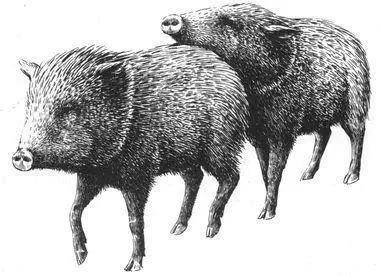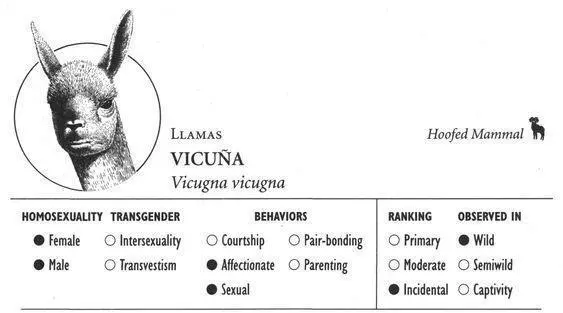Female Collared Peccary “riding” another female

Frequency: Homosexual mounting occurs commonly in Collared Peccaries during heat; it is less frequent in Warthogs, probably comprising 1–3 percent of all mountings. About 5 percent of all Warthog groups are “spinster” (female-only) groups.
Orientation: Females that participate in same-sex mounting are probably bisexual, since most also engage in heterosexual relations. Warthog female companions, for example, may mate with males and reproduce, even if they do not consistently socialize with males. More than a quarter of Warthog females do not get pregnant each season, however, so it is possible that some are involved exclusively in same-sex (bonding and/or sexual) activities.
Nonreproductive and Alternative Heterosexualities
Significant portions of Warthog populations do not procreate. In addition to the nonbreeding females and sex-segregated groups mentioned above, one- and two-year-olds that are sexually mature may remain with their mother’s group to help raise additional litters (rather than breeding themselves). These two species also participate in a variety of nonreproductive sexual behaviors. About 6 percent of heterosexual activity in Collared Peccaries, for example, involves females mounting males (REVERSE mounts), while another 22 percent of copulations are incomplete mounts by males. Males also frequently mount females during nonfertile periods, including pregnancy. Male Warthogs have been observed spontaneously ejaculating, including in their sleep. In addition, opposite-sex mountings in both species sometimes consist of a male mounting the female from the side without actual penetration (about 2 percent of sexual behavior in Collared Peccaries). Moreover, insemination does not necessarily occur even if penetration does, due to VAGINAL PLUGS. In both Collared Peccaries and Warthogs, a gelatinous barrier in the female’s reproductive tract is deposited by a male when he copulates, very likely insuring that sperm from any subsequent matings cannot impregnate the female. Since female Warthogs usually copulate with more than one male, and female Collared Peccaries often mate repeatedly with the same male (as many as 18 times in three hours), a large proportion of copulations are therefore probably nonprocreative. Females can also refuse copulations by covering the vulva with their tail and tightening their leg muscles upward. In Collared Peccaries, offspring are cared for not only by their biological mothers, but also by “nursemaids,” usually older sisters of the youngsters, that defend and nurse them. Often the nursemaids are not in fact sexually mature—they may be as young as six months old—with the amazing consequence that many nursemaids are themselves still nursing from their own “nursemaids.” It is thought that they are able to produce milk because they consume the mother’s placenta when she gives birth, perhaps thereby receiving some sort of hormonal influence from the mother. In Warthogs a number of violent counterreproductive activities also occur: adult males occasionally kill their younger brothers or cannibalize other males that they kill.
Other Species
Same-sex mounting also occurs in White-lipped Peccaries (Tayassu pecari) among both males and females.
Sources
*asterisked references discuss homosexuality/transgender
Bissonette, J. A. (1982) Ecology and Social Behavior of the Collared Peccary in Big Bend National Park, Texas. Scientific Monograph Series no. 16. Washington, D.C.: U.S. National Park Service.
Byers, J. A., and M. Bekoff (1981) “Social, Spacing, and Cooperative Behavior of the Collared Peccary, Tayassu tajacu. ” Journal of Mammalogy 62:767–85.
Child, G., H. H. Roth, and M. Kerr (1968) “Reproduction and Recruitment Patterns in Warthog ( Phacochoerus aethiopicus ) Populations.” Mammalia 32:6–29.
Cumming, D. H. M. (1975) A Field Study of the Ecology and Behavior of Warthog. Salisbury, Rhodesia: Trustees of the National Museums and Monuments of Rhodesia.
*Dubost, G. (1997) “Comportements comparés du Pécari à levres blanches, Tayassu pecari, et du Pécari à collier, T. tajacu (Artiodactylea, Tayassuidés) [Comparative Behaviors of the White-lipped Peccary and of the Collared Peccary (Artiodactyla, Tayassuidae)].” Mammalia 61:313–43.
Frädrich, H. (1965) “Zur Biologie und Ethologie des Warzenschweines ( Phacochoerus aethiopicus Pallas), unter Beriicksichtigung des Verhaltens anderer Suiden [On the Biology and Ethology of Warthogs, in View of the Behavior of Other Suidae].” Zeitschrift für Tierpsychologie 22:328–93.
Packard, J. M., K. J. Babbitt, K. M. Franchek, and P. M. Pierce (1991) “Sexual Competition in Captive Collared Peccaries ( Tayassu tajacu ) . ” Applied Animal Behavior Science 29:319–26.
Schmidt, C. R. (1990) “Peccaries.” In Grzimek’s Encyclopedia of Mammals, vol. 5, pp. 48–55. New York: McGraw-Hill.
*Somers, M. J., O. A. E. Rasa, and B. L. Penzhorn (1995) “Group Structure and Social Behavior of Warthogs Phacochoerus aethiopicus. ” Acta Theriologica 40:257–81.
*Sowls, L. K. (1997) Javelinas and Other Peccaries: Their Biology, Management, and Use. College Station: Texas A&M University Press.
*———(1984) The Peccaries. Tucson: University of Arizona Press.
*———(1974) “Social Behavior of the Collared Peccary Dicotyles tajacu (L.).” In V. Geist and F. Walther, eds., The Behavior of Ungulates and Its Relation to Management, vol. 1, pp. 144–65. IUCN Publication no. 24. Morges, Switzerland: International Union for Conservation of Nature and Natural Resources.
*———(1966) “Reproduction in the Collared Peccary ( Tayassu tajacu ).” In I. W. Rowlands, ed., Comparative Biology of Reproduction in Mammals, Symposia of the Zoological Society of London no. 15, pp. 155–72. London and New York: Academic Press.
Torres, B. (1993) “Sexual Behavior of Free-Ranging Amazonian Collared Peccaries ( Tayassu tajacu .)” Mammalia 57:610–13.

IDENTIFICATION: A small (3 feet at shoulder), camel-like animal with a slender body and a long, thin neck; coat is tawny brown or sandy-colored with white underparts and a chest mane. DISTRIBUTION: Andes Mountains of Peru, Bolivia, Argentina, Chile. HABITAT: High-elevation grasslands, plains. STUDY AREAS: Aricoma and Huaylarco, Peru.
Social Organization
Vicuñas live in cosexual groups usually containing 1 male, 3–10 females, and their offspring. In addition, all-male groups are a regular feature of Vicuña populations; they usually contain 5–10 animals, but may swell to include more than 150 individuals.
Description
Behavioral Expression: Female Vicuñas sometimes mount each other, with one animal straddling the other’s back with her forelegs. This is similar to a heterosexual mating, except the mounted animal does not typically lie down as she would if a male were mounting her (even in heterosexual interactions, though, the female does not always cooperate by lying down). In one case, a pregnant female chased another female and mounted her. Adolescent males also sometimes mount one another during play-fighting, remaining astraddle for up to a quarter of a minute. Play-fights are gentle frolics in which the two males push and wrestle each other with their heads and long necks, interspersed with chasing or rearing on the hind legs.
Читать дальше














